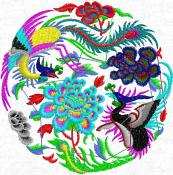Embroidery
Embroidery is one of the most precious jewels in Chinese culture. It has a long history since Neolithic age. And because of the quality of silk fibre, most Chinese fine embroideries are made in silk. After the opening of Silk Road in Han Dynasty, the silk production and trade became flourishing. Several major silk embroidery styles had been developed, like Song embroidery (Song Jin 宋錦) in Suzhou, Cloud embroidery (Yun Jin 云錦) in Nanjing and Shu embroidery (Shu Jin 蜀錦) in Sichuan. The major modern embroidery styles are Su embroidery, Xiang embroidery, Yue embroidery and Shu embroidery. Today, in spite of the high developed machinery, some very? intricate productions are still made by hand. |  |